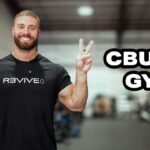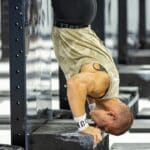The dumbbell curls are among the most iconic strength training exercises. This movement intended to strengthen your biceps muscle requires little equipment and is easily accessible. With the right technique and an appropriate number of sets, you can see tangible results.
But performing the dumbbell curl correctly means more than simply pumping iron up and down. You need proper form, the correct weight, and the right number of reps.
In this comprehensive guide, you’ll get a basic understanding of how to master dumbbell curls and get the results you want. Let’s take a look!
Jump to:
- What Is a Dumbbell Curl?
- Are Bicep Curls and Dumbbell Curls the Same Thing?
- What Muscles Do Dumbbell Curls Work?
- How to Do a Dumbbell Curl Properly
- What Are Dumbbell Curls Good For?
- How Often Should You Do Dumbbell Curls?
- How to Avoid Injury When Doing Dumbbell Curls
- Common Mistakes
- Dumbbell Curl Variations to Work the Entire Arm
- More Advanced Versions of the Dumbbell Curl
- Can You Build Muscle with Dumbbell Curls?
What Is a Dumbbell Curl?
The dumbbell curl is an isolated movement intended to increase the strength and size of the bicep muscle on the front of your arm. You’ll perform this exercise by grabbing the dumbbell with an underhand grip while lifting it from waist to shoulder level.
Are Bicep Curls and Dumbbell Curls the Same Thing?
In essence, the answer to this question is yes. A dumbbell curl is a movement that works your biceps as you curl your arm upwards; therefore the name bicep curl fits. However, the term dumbbell curls doesn’t always work interchangeably with other methods of doing bicep curls. You can use various techniques and methods to perform a bicep curl, including weight machines, barbells, dumbbells, bands, and your body weight.
Based on our testing, this is the best creatine for most people. It has the perfect dosage of creatine monohydrate per serving, which has been proven to increase muscle mass.
- Promote strength and muscle gains
- Tested for purity and safety
- Creatine has no known side effects
The dumbbell curl is just one technique commonly used to perform a bicep curl. Some people prefer barbell curls to achieve the same effect. But using a pair of dumbbells allows for a greater range of motion when working your biceps, which many people prefer. They like the freedom of movement that a pair of dumbbells offers.
What Muscles Do Dumbbell Curls Work?
Dumbbell curls target the three muscles that make up the bicep muscle: biceps brachii, brachialis muscle, and brachioradialis muscle. While this isolated movement is incredibly effective at increasing the size and strength of the bicep, it also improves grip strength and works the forearm extensor muscles.
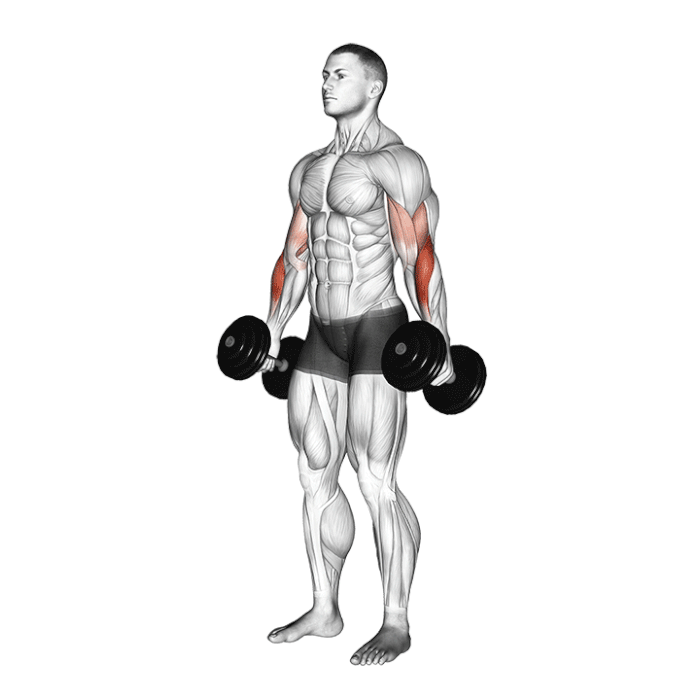
Some dumbbell curl variations work the tricep and shoulders as well. You can use compound exercises for your arms to achieve greater overall strength.
This exercise is excellent for muscle development throughout your upper body. When performed correctly you can also see benefits in your core muscles, including your abdominal muscles, back, and chest.
How to Do a Dumbbell Curl Properly
Start by choosing a set of weights that are light enough for you to control throughout the exercise but also heavy enough to build muscle mass. You want maximum muscle use here, so don’t be afraid to challenge yourself with heavier weights as long as you can maintain control of the movement the entire time.
Grab the dumbbell pair and get into the starting position. Your feet should be hip-width apart with a slight bend in the knees. Keep your posture tall with a slight bend forward at the waist so that your shoulders are over your hips.
With the dumbbells at your sides, slightly bend the elbows with your palms facing forward. Tighten your core as you squeeze the dumbbells and lift from waist level to the top of your shoulder. Keep your upper arms still throughout the entire exercise and be careful not to bend your wrists.
Squeeze at the top of the movement and pause briefly. Then, straighten your arms as you return to your starting position. Repeat 2-3 sets of 8-10 repetitions, keeping control of the weight the whole time.

What Are Dumbbell Curls Good For?
Besides giving you attractive, sculpted arms, dumbbell curls will also help improve your overall health and wellness as you grow stronger. You’ll gain additional range of motion in your daily activities and increase your lifts.
They also work your forearms and shoulders while improving your grip strength, so you’re getting comprehensive arm strength in the package. You’ll even strengthen the arm muscles that support elbow flexion and the elbow tendon, which is beneficial to your elbow joints and range of motion.
The dumbbell curl is a beginner-friendly weightlifting technique that anyone can use and modify simply by changing the weight of the dumbbell. So it’s a fantastic starting point for beginners just getting into strength training.
How Often Should You Do Dumbbell Curls?
The frequency at which you do dumbbell curls depends on your fitness level and training goals. Most people do them as often as 2- 3 times per week, usually in sets of 12-15.
Some more experienced strength trainers do dumbbell curls every day; however, it’s not recommended for beginners who could over-train and tear their muscles. Slow and steady wins the race, so start out at a comfortable weight, adding additional weight to promote hypertrophy with time.
When determining the sets and repetitions, consider your end goal. If you’re shooting for a toned look 2-3 sets of 12 -15 repetitions is ideal. To build muscle mass, experts recommend 4-6 sets of 6-12 repetitions. To increase your overall upper body strength, try doing 3-4 sets of 8-10 repetitions.
How to Avoid Injury When Doing Dumbbell Curls
Always check your form when you’re lifting any weights to avoid injury. Avoid any swinging motions from your shoulders, arms, hips, and back. Remain upright with your shoulders firmly in place and elbows stable at your sides for the duration of the movement.
Based on our testing, this is the best creatine for most people. It has the perfect dosage of creatine monohydrate per serving, which has been proven to increase muscle mass.
- Promote strength and muscle gains
- Tested for purity and safety
- Creatine has no known side effects
Engage your core and keep your spine in a neutral position. If you feel the need to swing or sway any part of your upper body stop immediately, correct your form, and consider a smaller weight.
As with any exercise, form is the key to achieving the results you want. Listen to your body and if you experience pain, stop and reset.

Common Mistakes
We wanted to touch on some common mistakes we see with the dumbbell curl to help you avoid injury. and make sure you are isolating the muscle correctly so that every movement supports the definition you want in your biceps.
Going Too Fast
Going too fast can cause you to lose your form, which makes it harder to isolate the bicep muscle or injury. You should do bicep curls at a slow and steady pace to avoid injury and ensure proper form with each curl.
Improper Elbow Position
Poor elbow positioning is a common injury cause. If you don’t hold your elbow stable to your side, it might swing forward so you fail to isolate the bicep properly. You might inadvertently engage the deltoid muscles instead.
Pin the elbows to your sides and keep them there through each rep. The elbow-to-shoulder angle should be sharp and controlled to avoid dipping and improper muscle use.
Using Swinging Momentum
You get results from dumbbell curls when you maintain slow, controlled movements. It’s tempting to take a shortcut and use swinging momentum to get the dumbbell from waist to shoulder. However, you’re more likely to sustain injury this way, and you certainly won’t get the benefit of the bicep isolation exercise.
When the weight of the dumbbell gets to its heaviest point at the midpoint of the curl, it can also be tempting to sway your shoulders or back. Engage your core and remember to maintain that slight bend at the waist. This will keep your shoulders firmly in place just over your hips and mitigate your risk of injury.
Dragging or Dropping
Dropping or dragging the weight happens towards the end of the curl when it can be tempting to release control of the dumbbell too early. Keep constant tension on the dumbbell throughout the entire movement from top to bottom.
Proper core stability can help. Oftentimes if you’re losing control of the movement, you need a little extra tension in your abdominals to keep it steady. Otherwise, you can try dropping weight.
Too Heavy Weights
If the weights you’re using are too heavy, it will be difficult to manage this isolation exercise. You’ll notice yourself losing the proper form as you engage other muscles to lift the heavy weight.
You might think you’ll grow stronger faster by jumping to heavier weights, but it actually makes it much harder to strengthen your biceps in the long run. You’re trying to isolate the bicep to strengthen it, but using too heavy weights will call on other muscles, even causing muscle strains.
If you start to lose your form try using a lighter weight. You can always increase weight, but it’s harder to come back from an injury sustained with too heavy weights.
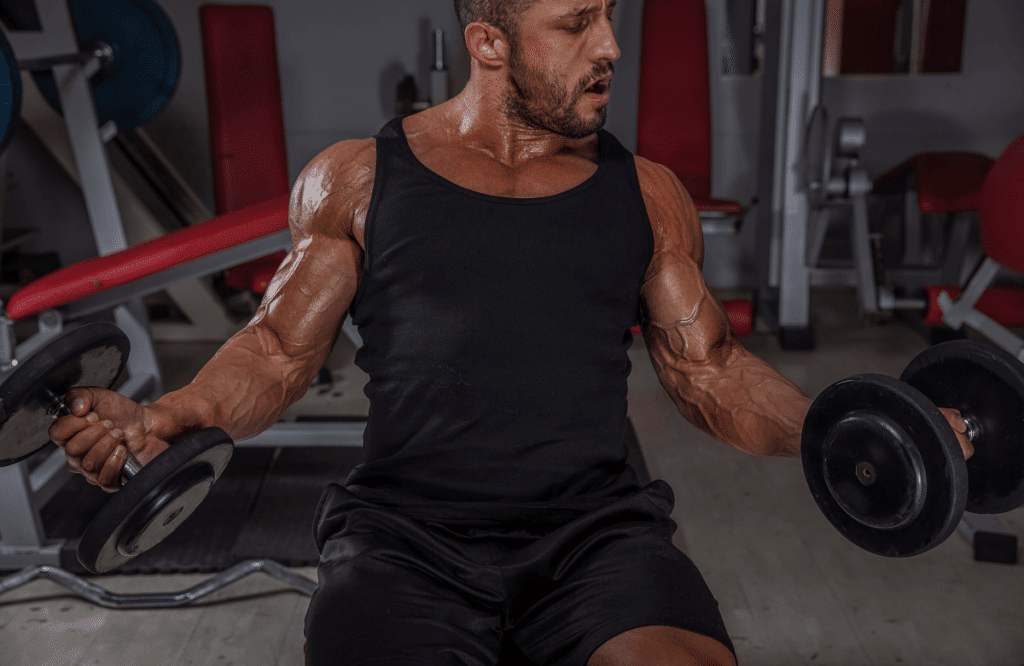
Dumbbell Curl Variations to Work the Entire Arm
While you can perform dumbbell curls the same way every time, it’s nice to add some variety to your workout. It keeps things interesting and challenging. It works muscles differently so that you’re getting more out of each move. We’ve listed a few variations here to help keep your workout fresh.
Shoulders – Lying Down Cable Curls
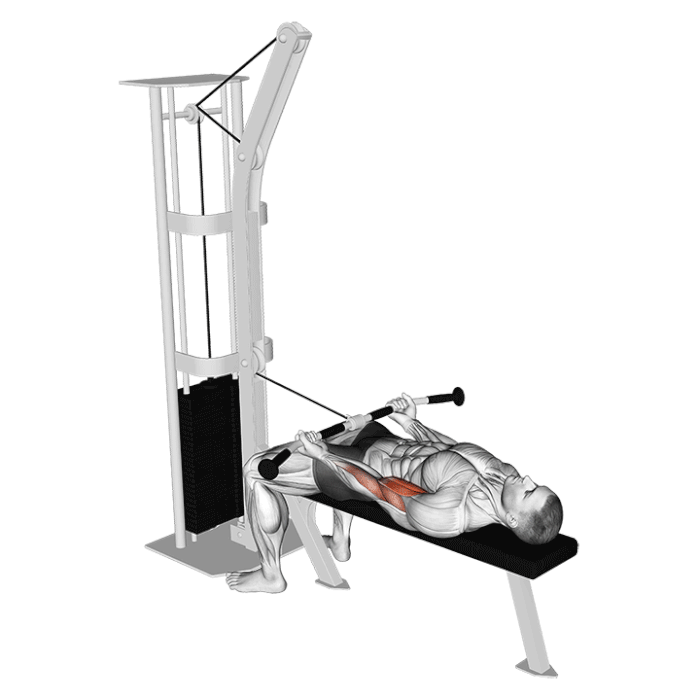
The muscles around your shoulder joint are a small but strong group of muscles. For better shoulder stability and strength in your rotator cuff, it’s important to work these muscles regularly. With the right variations, dumbbell curls can help.
Grab a straight bar or E-Z attachment and lie flat on the bench or a mat on the floor. Bend your knees and place your feet flat on the floor close to the weight stack. Extend your arms but keep your elbows close to your sides.
With controlled movements, bring the bar to your chest. Breathe out and squeeze your biceps at the top of the movement before lowering back down. Do 2-3 sets with 12-15 repetitions each.
Forearms – Zottman Curl

Dumbbell curls can work multiple forearm muscles including forearm extensor muscles, pronator muscles, and even the tendons around your forearm bone.
If you’re looking for stronger forearm flexors, try the Zottman curl. It’s named for the 19th-century strongman George Zottman, who was made famous for his bulging biceps and massive forearms.
This move is pretty straightforward, beginning with both dumbbells at your sides in a supinated (palms up) grip. Curl the weight to the top of your shoulder and twist the weights into a pronated (palms down) grip before lowering back down to your sides. Do 2-3 sets of 10-15 reps each.
Outer Bicep – Hammer Curls

While you might think primarily of your inner biceps, there’s an outer bicep too. Working your outer bicep means shaping and toning the outside of your upper arm too, and hammer curls are a great way to work this muscle grouping.
Begin with the proper stance–knees slightly bent, feet hip-width apart, shoulders and upper body stationary. With both weights tightly gripped in each hand, curl the dumbbells to the top of the shoulder while keeping the wrists in line with the forearms. Squeeze at the top and lower back down. Aim for 2-3 sets of 10-15 reps. h
More Advanced Versions of the Dumbbell Curl
Once you’ve mastered the basic variations of the dumbbell curl try some of these exercises to keep your arm workouts interesting and new.
Preacher Curls
You perform preacher curls using a preacher bench and either a barbell or an E-Z bar. Grab the bar with an underhand grip, while seated at the bench, your upper arms and chest should rest on the arm pad.
Maintain a slight bend in the elbow as you begin to curl. Squeeze your biceps and flex your elbows until the bar is level with your shoulders. Slowly lower back down and repeat. Two-three sets of 8-12 reps should do it.
TRX Bicep Curl
The TRX Bicep Curl is a body weight resistance exercise that uses suspension cables instead of traditional hand weights. The suspension cables should be anchored above your head with the straps attached.
With your body facing the anchor point, grab the strap handles and move your body into standing plank position. Engage your core muscles and slightly lean back to add tension to the cables. Elbows should be bent with hands close to your forehead.
Once you’re in position and feel in control of the movement, slowly lower your body back while maintaining a tight plank pose until your arms are straight. Then, curl back into the starting position. Do this for 2-3 sets at 8-12 reps each.
Band Curls
Rather than a dumbbell, you’ll need an exercise band for this one. Step both feet onto the band about shoulder width apart with a handle held firmly in each hand. After checking that your posture is properly aligned, begin to curl the handles up to your shoulders, maintaining a squeeze in the bicep as you reach the top of the shoulder. Then, slowly lower back down. You can do 2-3 sets of 8-12 reps.
As you progress in this exercise, try moving up to a tighter tension band. The greater the tension, the more intense the exercise.
Spider Curls
Spider curls are a variation of the dumbbell curl where you support your chest and upper body with an incline bench. This technique keeps your upper body stationary so that you can maintain an isolated movement in the bicep.
Begin by resting your chest against the incline bench at a 45-degree angle, and curl the dumbbells to the top of the shoulder before lowering back down. Once again, 2-3 sets of 8-12 reps should do it.
Can You Build Muscle with Dumbbell Curls?
When done correctly, dumbbell curls can be one of the best exercises for building muscles in your arms. This simple exercise is highly effective in targeting the three muscles that make up the biceps: biceps brachii, brachialis, and brachioradialis.
It works both the short and long bicep head, giving your arm an all-over increase in muscle mass. Incorporating this movement into your weekly workout routine will help you see results quickly, and before you know it, you’ll be hefting large objects with ease. Not to mention the definition that becomes visible in a matter of weeks when performed regularly and properly.












